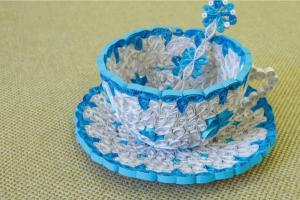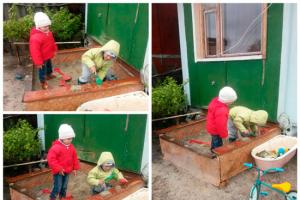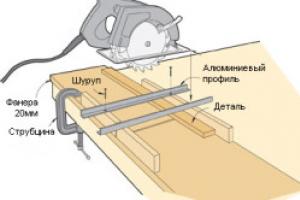The most common problem encountered by those living in wooden house, is damage to its load-bearing support - the lower crowns.
In our article we want to tell you how to replace or repair the lower crowns with your own hands wooden house.Wood is one of the most ancient and popular materials for building houses. It has many advantages, including durability, but over time, wooden buildings, even those built using modern technologies, using all kinds of treatments and impregnations, may require repairs.
Particularly relevant this problem for embedded logs, which perform a load-bearing function and are most susceptible to the effects of an aggressive external environment, in particular, melt and ground water, and precipitation.

Because of external factors crowns wooden structure they begin to rot, mold and mildew appear, and insects infest them that undermine the wood structure; as a result, an urgent complete replacement of the mortgages, strengthening, or their partial local restoration is required.
Causes of damage to the lower crowns of the house and options for their elimination
Before starting work to localize damage to the crowns, it is necessary to inspect them and identify the causes. Based on the results of the inspection, the issue of methods for eliminating them is decided.

Violation of technology during construction, as well as damage or wear of the waterproofing protection can lead to rotting of the wooden base. If this problem is noted on time, it is solved after complete drying by impregnation with various specialized mastics, as well as by completely replacing the waterproofing.
Repairs can be made in five main ways:
- Partial replacement. Only the damaged log is replaced. The method is used only as a temporary one, when not the entire frame is damaged, or for some reason raising the house is impossible. The log must be removed and replaced with a new one, treated with protective agents.
- Full analysis and reinstallation of the structure. The technology is used for non-residential buildings in cases where it is necessary to change not only the crowns, but also some others wooden elements buildings.
- Replacing the crown with brickwork. It is also possible to partially replace only damaged areas.
- Jacking method. Used on strip and solid foundations. The method allows not only to easily replace mortgages, but also to repair, waterproof and raise the foundation.
- Using specialized metal hangers. An expensive technology that requires finding or making a structure for hanging a house in accordance with the perimeter dimensions of the house, and using special equipment.
How to determine that crowns need replacement
The need for replacement is determined by visual inspection. When lightly tapping with a mallet, in case of internal decay, a dull echo will be heard. It is also necessary to check the second and third crowns.
In addition, special attention should be paid to the presence of small passages of wood-boring beetles. It should be noted that even one larva is capable of grinding down the structure of an entire log to a rotten state in a short time.
You also need to inspect the foundation. The presence of cracks on it may indicate that it is collapsing and needs restoration.

Partial repair of crowns in stages
Spot repairs can be done when the wood has begun to rot in one or more areas of the base, when it makes no sense to completely change the embedded parts.
For this:
- Carefully inspect the surface of the logs. Using a chisel and other suitable tool, clean the log around the rotten area, determine the depth of the damage.
- Stepping 40–50 cm away from the rotten area to the right and left, screw wooden ties on the inside and outside of the house to a height of 2.5–3 logs.
- Using a chainsaw or jigsaw, carefully remove the damaged piece of wood.
- Make a suitable, even notch in its place and install an insert into it that fits the dimensions using the tongue-and-groove method.
- Secure the insert firmly using dowels.
- All cracks should be caulked, and the wood should be treated with water-repellent mastic.
 1 - size of the area to be removed; 2 - wooden ties; 3 - old log; 4 - insert
1 - size of the area to be removed; 2 - wooden ties; 3 - old log; 4 - insert
How to replace mortgages with brickwork
Sometimes it is not necessary to jack up the building in order to replace the crown part with brickwork.
For this:
- Knock out the damaged log from one corner using a sledgehammer. Install supports made of metal or wood into the free cavity, or fold a brick column. The same procedure must be performed on the other side.
- Clean the foundation from dirt and dust and repair it if necessary.
- Lay roofing material on the surface of the foundation in 2 layers.
- Lay out instead of a mortgage log brickwork according to its height in the central part.
- Then remove the supports, and also fill the space with bricks with surface waterproofing and treating the lower parts of the logs with mastic or other water-repellent solutions. In this way, you can replace individual parts of the mortgages or the entire lower crown.

Updating the crowns of a house using the jacking method
Preparatory work
The most common way to update lower crowns involves using a jack. Before starting work, it is necessary to prepare the structure for lifting:
- Lighten the weight of the building as much as possible.
- Remove, if any, part of the outer façade cladding.
- Secure the lower undamaged logs with vertical wooden ties in half-meter increments, preferably both on the outside and on the outside. inner sides s.
- Remove baseboards in the house and, if possible, move the floor away from the walls.
- Disconnect hard-wired communications: gas (by the service organization), water, sewerage.
- If a stove or fireplace is installed in the house, then it is necessary to remove part of the floor around it, dismantle the chimney or part of the roof and floor covering around the chimney.

Materials and tools
Prepare the following materials:
- Fire retardant for wood.
- Bitumen mastic.
- Suitable size logs or beams.
- Any sealing material for logs (tow, etc.).
- Bricks, cement-sand mixture for masonry - if it is necessary to update the brick foundation or replace the crowns of the house with masonry.

Tools:
- Jacks (with a load capacity of at least 2.5–5 tons) - 4 pieces, as well as 4 metal plates for support.
- Wide blocks or timber as support.
- Levers ( metal channel, I-beam or timber).
- Plane.
- Axe.
- Chainsaw.
- Sledgehammer.
- Chisel.
- A pre-mounted channel or beam support lintel for safety and support of the structure.

Lifting the building on jacks. Phased replacement of crowns
The work is carried out in the following order:
- Mark and cut out the dimensions of the jacks for their locations in the upper logs of the lower crown, with a distance of 1 meter from the corners of the house. Installation of the jack is carried out depending on the type of foundation.
 1 - lower log of the crown; 2 - lever support; 3 - wooden wedges; 4 - top log of the crown; 5 - lever (channel); 6 - strip foundation; 7 - jack
1 - lower log of the crown; 2 - lever support; 3 - wooden wedges; 4 - top log of the crown; 5 - lever (channel); 6 - strip foundation; 7 - jack
- Install support blocks under the jacks and place the devices on them, also placing metal channels/levers on their surface if the foundation is strip. If it is columnar, the jacks are installed directly under the building.

- Lift the house evenly with the participation of 3 more assistants. Don't rush, watch for a uniform rise.
- After lifting, the lower logs can be removed immediately.
- After raising the house on jacks, it is necessary to install supporting structure(in the case of a columnar foundation) or place wedges (on a strip foundation) and leave them while the repair of the foundation and its waterproofing, dismantling of damaged crowns and treatment of the wood with fire protection continues.
- After the jacks are lowered, it is necessary to lay a new load-bearing log on them and, lifting the device above the supports, secure it tightly. This needs to be done on all sides of the building.
- Next, all gaps must be processed and plugged with tow.

- It is not recommended to lift the building in stormy weather, as well as during periods of capricious soil behavior - in winter and during floods.
- Do not place your limbs under a raised structure unless you are confident that it is firmly secured.
- Carefully inspect the logs and carefully treat them with specialized products.
- If you are not confident in your abilities, entrust the work to professionals. On average, the cost of replacing the lower crowns can cost 30–40 thousand rubles.
- The most the best material Larch logs will serve as mortgages. They are expensive, but at the same time durable. Their construction is moisture-resistant and durable and can “live” up to 50 years.

Thus, you can replace the lower crowns of the house and extend the life of the building, even with significant damage to the load-bearing logs, on your own. And although in some cases it may seem difficult work, it is quite feasible if all instructions and recommendations are carefully followed.
Quite often we solve problems with floors in private wooden houses for our Customers, be it a complete replacement with insulation, or a replacement finishing coating floor. The main reasons why people turn to us for this are subsidence of floors, violation of the geometry of planes, partial rotting and destruction of floor joists, insufficient or complete absence of insulation (cold floor), etc.
In most cases, the reasons causing the data unpleasant consequences, are violations of the technology for installing floors and floor coverings, insufficient or absent ventilation in the underground, proximity groundwater, low height of the base of the house and ventilation holes, and the most banal one is saving on the cross-section and number of floor transitions and the thickness of the load-bearing layer (the floors “trampoline”). Everything is solvable, and absolutely any situation can be corrected if there is a desire and cash. The most important thing is not to let the problem get worse, otherwise the day is not far off when it will be simply dangerous to walk on the floors, and they may even fail completely (we’ve seen this happen too). So, we have sorted out the main reasons for the disruption of functionality. Now let's get down to business.
Dismantling the floor.
 The first step when replacing and/or insulating floors with your own hands will definitely be to dismantle the baseboards around the perimeter of the room and the existing flooring, and possibly translations. No special skills are required here, the main thing is accuracy in work and attentiveness when disassembling, so as not to disrupt communications (mostly electrical wiring and sewerage, possibly plumbing with heating). After all this, the accumulated construction waste should be removed (there will be a lot of it, so prepare a place for its disposal in advance). Often, it is no longer possible to carry long boards and translations through the doors, so we either cut them right in the room (inconvenient, and when using a chainsaw, the smell of exhaust fumes remains) or we feed them through the windows (most often this is what they do).
The first step when replacing and/or insulating floors with your own hands will definitely be to dismantle the baseboards around the perimeter of the room and the existing flooring, and possibly translations. No special skills are required here, the main thing is accuracy in work and attentiveness when disassembling, so as not to disrupt communications (mostly electrical wiring and sewerage, possibly plumbing with heating). After all this, the accumulated construction waste should be removed (there will be a lot of it, so prepare a place for its disposal in advance). Often, it is no longer possible to carry long boards and translations through the doors, so we either cut them right in the room (inconvenient, and when using a chainsaw, the smell of exhaust fumes remains) or we feed them through the windows (most often this is what they do).
Device of sexual translations.
In general, if it is necessary to replace the floors, it is rare that the translations are not changed at the same time, because if the covering has already rotted, then the load-bearing beams are definitely also damaged.  Modern technologies laying floors and installing a supporting frame under them necessarily involves treating both beams and subfloor boards with hard-to-wash antiseptics, which significantly reduce the degree of damage to them by fungus, insects and pathogens. The dacha squatters of the last century were rarely puzzled by this, which is also why translations collapsing right in the hands are not a rarity, but rather a pattern. So, be sure to purchase in construction stores antiseptic, and don’t be lazy to treat the wood, this is important.
Modern technologies laying floors and installing a supporting frame under them necessarily involves treating both beams and subfloor boards with hard-to-wash antiseptics, which significantly reduce the degree of damage to them by fungus, insects and pathogens. The dacha squatters of the last century were rarely puzzled by this, which is also why translations collapsing right in the hands are not a rarity, but rather a pattern. So, be sure to purchase in construction stores antiseptic, and don’t be lazy to treat the wood, this is important.
What else? Organization of proper air exchange in the underground. main reason, along which floors and floor joists rot - lack of proper air exchange. Natural ventilation– the key to the long life of your floors and a healthy indoor climate. Often in private houses on the ground floor there is a persistent smell of mold, especially in spring and autumn. This is the first sign that there are either not enough vents or they are organized incorrectly (there are blind pockets, non-through vents, etc.). Therefore, when major renovation floors, close attention should be paid to this, and, if necessary, errors made during construction should be corrected. It would also be a good idea to check the proper organization of waterproofing of the foundation and the condition of the backfill under the house (most often it is sand, it is possible to fill the subfloor with expanded clay).
Construction and installation of floor joists.
 This stage is important in terms of selecting the correct sections load-bearing elements, here all kinds of online and offline beam calculators can help you. Main principle– the section must be selected with a margin for the load, the required lag pitch is mainly selected based on the selected finishing coating (one for a tongue-and-groove board, another for plywood, taking into account the subsequent laying of the laminate, etc.), or based on the width of the insulation mats . What else should you pay attention to? Floor level. IN Lately The main trend in the installation of floors in private wooden houses is the installation of the latter in one level on the entire floor, without level transitions. Accordingly, all the boxes interior doors assembled and installed without thresholds, with the exception of kitchen and bathroom doors. This is undoubtedly more convenient to use.
This stage is important in terms of selecting the correct sections load-bearing elements, here all kinds of online and offline beam calculators can help you. Main principle– the section must be selected with a margin for the load, the required lag pitch is mainly selected based on the selected finishing coating (one for a tongue-and-groove board, another for plywood, taking into account the subsequent laying of the laminate, etc.), or based on the width of the insulation mats . What else should you pay attention to? Floor level. IN Lately The main trend in the installation of floors in private wooden houses is the installation of the latter in one level on the entire floor, without level transitions. Accordingly, all the boxes interior doors assembled and installed without thresholds, with the exception of kitchen and bathroom doors. This is undoubtedly more convenient to use.
How to do it? If we are changing the floor in a particular room, then we need to start from the level that already exists in the adjacent one. Here a laser or water level helps us, with the help of which we transfer marks to the corners of the room. After this, we subtract the future thickness of the floors (tongue-and-groove boards from 28 to 45 mm, plywood from 18 to 22 mm, a smaller thickness does not fit from the boards without organizing the flooring), put down new marks - this is the plane of the floor joists. Then we set the outermost joists of the floors according to the marks and secure them. A prerequisite for relying translations on concrete base– waterproofing the contact area.
An independent floor is considered good form when translations are not tied to the walls of the house. They can be mounted on the cheeks of the foundation, or on posts indoors. In this case, it is better if these are not pillars made of foundation blocks or bricks (from practice - without a proper foundation they tilt and do not perform their functions after 3-5 years), but drilled and cast into a sleeve made of asbestos-cement or plastic pipe piles. The location of the piles is individual for each room, we are guided by beam calculators to calculate the deflection and common sense; too many complicate and increase the cost of the whole process.
Go ahead. Now we have something to support the logs on; the outermost ones have already been mounted. Collecting the rest into the system is a matter of technology. You need to tighten the lace along both edges and the middle, and continue installing the floor transfers with the required step, controlling the gaps under the tensioned threads (should be equal and minimal). As a result, we get a flat plane.
We assemble subfloors.
 The rough (black) floor is added as an additional layer when insulating floors; most often it is a plank flooring (on cranial bars fixed along the inside of the joists) made of edged boards with a cross section of 150x25 or 100x25 mm, pre-treated with an antiseptic. Adds rigidity to the entire floor structure, serves as an additional insulating layer, and protects finishing the floor from moisture, and the whole insulation pie lies on it. How to make subfloors correctly? We will need bars with a cross section of 30x30 mm, and an edged inch board. We screw the cranial block onto the inner sides of the translations and measure the width of the gaps between the joists. We cut the boards to a size slightly smaller than the span, and lay the boards tightly on the bars. Actually, that's all.
The rough (black) floor is added as an additional layer when insulating floors; most often it is a plank flooring (on cranial bars fixed along the inside of the joists) made of edged boards with a cross section of 150x25 or 100x25 mm, pre-treated with an antiseptic. Adds rigidity to the entire floor structure, serves as an additional insulating layer, and protects finishing the floor from moisture, and the whole insulation pie lies on it. How to make subfloors correctly? We will need bars with a cross section of 30x30 mm, and an edged inch board. We screw the cranial block onto the inner sides of the translations and measure the width of the gaps between the joists. We cut the boards to a size slightly smaller than the span, and lay the boards tightly on the bars. Actually, that's all.
Insulation of floors in a wooden house.
 It is not difficult to properly insulate the floor in your house with your own hands. The insulation pie, if you follow the technology, consists of subfloors, a waterproofing layer, a thermal insulation layer, and a vapor barrier. The process itself is simple. On top of the subfloor and floor joists using construction stapler We install a waterproofing membrane that goes around each transition, monitor the connections to the walls, and control its integrity. Then we place the required layer of insulation into the resulting pockets; it is not worth doing less than 100 mm (today there is plenty to choose from on the market, so such anachronisms as shavings with sawdust, glass wool, expanded clay, and fallen leaves have not been used for a long time). The choice of manufacturer is the Customer’s business; we, in turn, most often recommend and use Knauf products in our work. We pass along the walls along the transfers with a roller of insulation, checking the absence of cracks and cold bridges (the junctions of the mats must be covered with the next layer). There are no fundamental differences between roll and briquette insulation in floors; you can use any, it’s a matter of ease of use. We do not recommend using polystyrene foam and polystyrene foam - mice love them very much, and they burn hotly, releasing deadly substances.
It is not difficult to properly insulate the floor in your house with your own hands. The insulation pie, if you follow the technology, consists of subfloors, a waterproofing layer, a thermal insulation layer, and a vapor barrier. The process itself is simple. On top of the subfloor and floor joists using construction stapler We install a waterproofing membrane that goes around each transition, monitor the connections to the walls, and control its integrity. Then we place the required layer of insulation into the resulting pockets; it is not worth doing less than 100 mm (today there is plenty to choose from on the market, so such anachronisms as shavings with sawdust, glass wool, expanded clay, and fallen leaves have not been used for a long time). The choice of manufacturer is the Customer’s business; we, in turn, most often recommend and use Knauf products in our work. We pass along the walls along the transfers with a roller of insulation, checking the absence of cracks and cold bridges (the junctions of the mats must be covered with the next layer). There are no fundamental differences between roll and briquette insulation in floors; you can use any, it’s a matter of ease of use. We do not recommend using polystyrene foam and polystyrene foam - mice love them very much, and they burn hotly, releasing deadly substances.
 The next layer will be a vapor barrier membrane, we also install it using a stapler, making sure that the junctions with the walls and the overlap are observed. After this, you need to organize ventilation between the insulation and the base of the floor; the easiest way is to sew planed thin slats over the joists, fortunately, they are not expensive. We've sorted out the insulation, let's move on.
The next layer will be a vapor barrier membrane, we also install it using a stapler, making sure that the junctions with the walls and the overlap are observed. After this, you need to organize ventilation between the insulation and the base of the floor; the easiest way is to sew planed thin slats over the joists, fortunately, they are not expensive. We've sorted out the insulation, let's move on.
Plywood flooring under laminate.
In the last few years, when replacing floors in a country house, customers are increasingly choosing laminate as a finishing floor as a finishing floor. The choice is not accidental - the highest performance qualities and a huge variety of colors and textures speak for themselves. Lasts a long time, unpretentious, low price square meter, does not dry out like a tongue and groove board, no need to paint - perfect option. Linoleum? Not exactly what you need - it doesn’t breathe more than completely, the only plus is ease of cleaning and a slightly lower price, and even then not always. Can be placed in the hallway, kitchen and bathroom.
 So, laminate - installation in a country house country house. We need a smooth and durable base that does not “walk” with changes in temperature and humidity. What to choose? There is no need for plank flooring made from edged lumber - the moisture content of the source material is 12-14%, the thickness of the boards is different. OSB sheets, even 12.5 mm thick do not have sufficient rigidity. DSP - let's say, cement in the house, especially on the floor, is never comme il faut. What remains is the plywood. The thickness that suits us starts from 18 mm, better if it is 21 mm. Which one to choose? Definitely it should be birch plywood, since plywood is made from coniferous species not strong enough and more demanding on the frequency of transfers. Grade, everything is also simple here, we don’t need polished of the highest quality, since this is not a finishing coating. Accordingly, you can save a lot of money if you contact the manufacturer or official dealer directly and buy the so-called economy class, which is significantly cheaper, and for our purposes fits perfectly.
So, laminate - installation in a country house country house. We need a smooth and durable base that does not “walk” with changes in temperature and humidity. What to choose? There is no need for plank flooring made from edged lumber - the moisture content of the source material is 12-14%, the thickness of the boards is different. OSB sheets, even 12.5 mm thick do not have sufficient rigidity. DSP - let's say, cement in the house, especially on the floor, is never comme il faut. What remains is the plywood. The thickness that suits us starts from 18 mm, better if it is 21 mm. Which one to choose? Definitely it should be birch plywood, since plywood is made from coniferous species not strong enough and more demanding on the frequency of transfers. Grade, everything is also simple here, we don’t need polished of the highest quality, since this is not a finishing coating. Accordingly, you can save a lot of money if you contact the manufacturer or official dealer directly and buy the so-called economy class, which is significantly cheaper, and for our purposes fits perfectly.
The process of laying plywood on ready-made transfers is simple, the most important thing was not to make a mistake during the installation of transfers so that the joints of the sheets fall in the middle of the joists, this is critical. The step-by-step installation of plywood on the floor is as follows:
- we check the diagonals of the room, determine the right angle along the walls;
- temporarily lay the sheets along the walls, where we have defined a right angle (or its similarity), with the letter G;
- we check that the sheets are laid correctly, whether they do not move away from the joint line in the middle of the translation, if necessary, we cut the sheets along the wall to achieve the required result (it is important - only one side is cut along the wall, otherwise all the sheets will have to be cut later);
- We provide small gaps near the walls for possible expansion of the plywood;
- Then everything is simple, we pre-drill the plywood with a drill of a smaller diameter than the self-tapping screw and fasten it (life hack - we fix the joints of the sheets between the translations with scraps of plywood or boards, which we screw, slipping them under the previous sheet to make a continuous and rigid flooring).
 This way we get a flat and rigid base for the subsequent laying of the finishing coating. In this particular case, it was laminate; the baseboards were chosen to match it, plastic. The final result is in the photo.
This way we get a flat and rigid base for the subsequent laying of the finishing coating. In this particular case, it was laminate; the baseboards were chosen to match it, plastic. The final result is in the photo. Video - the process of replacing and insulating floors in a private wooden house.
Natural Construction Materials have always been highly valued by customers, they are durable, environmentally friendly and durable. However, like any material, they are not eternal. When building a wooden house, the problem of rotting of the lower crowns often arises. The reason is a violation of construction technology, unforeseen circumstances or operational errors. To correct the situation, old crowns in a wooden house are replaced with new ones - this process is complex and expensive from a financial point of view.
Replacing crowns in a wooden house
In the last century, the owners themselves were responsible for replacing crowns, inviting neighbors to help. Now it is easier to hire qualified specialists for this work. Construction crews have practical experience— for them, replacing crowns is a common thing and does not cause difficulties. For example, do not try to build a residential building yourself. Order construction of timber houses from SK Smirnov in Moscow, St. Petersburg, Veliky Novgorod and other cities of Russia.
This article talks about technologies for replacing crowns in a wooden house, however, this information is for informational purposes only and does not constitute instructions for action.. We recommend that you first consult with builders, since only the precise eye of a professional will give an accurate assessment of your problem.
The procedure for repairing the lower crowns is as follows:
- if the log house has a so-called blockage, you need to remove it, clean the lower logs from earth, clay or sand;
- Before repairs, it is recommended to dismantle doors and windows, otherwise door leaves And window frames may become deformed and glass may crack;
- then, in all cases, except for very minor fragmentary repairs, the frame is raised using jacks (you can lift only one side for one-by-one repairs or the entire frame);
- after these operations the crowns are changed;
- the repaired log house is carefully caulked; The frame is lowered into place, windows and doors are put in place.
Methods for repairing minor damage
How to replace the bottom crown of a wooden house without raising the structure
Sometimes a situation arises when the lower crown of the house is not completely rotten - it is possible to replace the damaged area, especially if it is on strip foundation.
Repairing lower logs without raising the house:
- We determine the damaged area and its area;
- On both sides of the damage we retreat about 40 cm;
- We install special ties, 3 crowns high, this will allow you to remove the damaged area using a chainsaw;
- In place of the removed area we insert a new, pre-prepared log of the same diameter;
- Using dowels, we connect the old log with the new insert and caulk all the resulting cracks with moss.
Using this technology, it is possible to replace the entire lower crown, however, it will not be as strong as a solid log, but this technology is suitable as a temporary option.
How to replace the bottom crown of a house with brickwork
It is possible to build brickwork instead of rotten crowns without raising the structure or with it. If the house is located directly on the ground, then this method will come in handy. If a wooden house stands on a foundation and it needs to be raised, then the window frames are removed before doing this - when using jacks, they can be “moved”. Lifting of the log house is done in the corners. Afterwards, the original base is cleaned and the brickwork is built up.
Repairing a house on a strip foundation
If defects appear on the crowns of a wooden house built on a strip foundation, it is impossible to do without raising it. As mentioned above, the structure can be lifted using jacks, however, if there is a strip base, it must first be partially destroyed. Depending on the degree of damage, the frame is raised completely or in parts. The minimum height is 10 cm. This technology has one drawback: after the renovation is completed, the foundation of the house is broken, which means its strength is reduced.
So, the most popular technologies for replacing the lower crowns of a wooden house are considered. We remind you that it is necessary to carry out the work qualitatively and in accordance with all the rules. this work Only a special team of professionals can do it.
Replacing a wooden floor with a reinforced concrete one
Any structure consists of several basic elements: foundation, ceiling, roof and walls. Distinctive feature wooden floors is the emerging need to replace them. This is due to the minimum service life. If the service life of foundations, walls and covers made of reinforced concrete is almost the same, then wooden structures are in use for about 50 years.
Relevance of replacement
Most of the buildings and structures that need repair work ah and were built a long time ago, have wooden interfloor ceilings. After a certain period of time, such structures lose their quality and functional properties, so a need for change arises.
Solution topical issue of old buildings is to avoid wood. Buildings with wooden floors in most cases have a small number of floors and thick and powerful load-bearing walls. Some buildings are of historical value and act as museums.
After analyzing the house, experts decide which floor to replace the wooden one with: a protective structure made of reinforced concrete slabs or reinforced concrete, representing a monolith.
A brief excursion into history
Structures are divided into monolithic and prefabricated. Monolithic structures were used to a limited extent until the mid-90s of the last century. This was due to the lack of:
- special mechanisms and equipment that allow delivering concrete mixture for a structure under construction;
- reversible formwork.
- Since the 50s of the 20th century, construction technologies have implied the use of prefabricated reinforced concrete structures.
Work principles
The basis for replacing wooden floors with a practical reinforced concrete structure is the use of beams. Their ends are laid in load-bearing enclosing structures. And also in existing recesses in which old beams were located or in open additional holes.
In almost all structures in which there is a need to replace floors, load-bearing walls represent longitudinal vertical enclosing structures located in parallel. Therefore, when creating a project or repair plan, it is necessary to take into account the distribution of the load on these walls.
Using a monolithic structure for these works is not advisable. Since to receive necessary support on the walls, there is a need to create holes along their entire total length, which leads to a weakening of the wall structure.
The prefabricated ceiling is a complex of cross beams, blocks located between these elements, and a reinforced monolith. An important element of formwork work has a rectangular base made of lightweight reinforced concrete and an upper base made of reinforcement.
For a single floor, they use, taking into account the load on load-bearing walls, wide-profile standard profiles - I-beams or metal profiles, characterized by ease.
Characteristics of the building materials used:
- profiles of steel products;
- brand and type of concrete;
- thickness of reinforced concrete coating;
- other parameters.
They are determined when creating a project before the start of major construction and repair work, taking into account the condition of the structure, operating features and the main repurposing of the structure.
The work must be entrusted to competent and qualified specialists. Our company has extensive experience and is focused on potential clients, so we guarantee the high quality of the offered relevant and in-demand services.
Replacement wooden structures on reinforced concrete floors helps to significantly strengthen the structural system of the entire structure and increase the capability indicator. We will help make your home more sustainable.
Repair apartments , suburban houses , roof, foundations, fences, fencing, autonomous gasification , private sewerage, finishing facades, systems water supply from wells and boreholes, professional modern boiler rooms For private houses And enterprises.
Publication tags of the Design-Presige company.
Technical support for the structure of a wooden house is a prerequisite for extending its service life. One of the most serious problems that necessitate the repair of such buildings is biological damage. It can manifest itself in the form of rotting, fungal development, and so on. Ultimately, it is necessary to replace the crowns in a wooden house, otherwise the process will develop and cover the entire supporting structure.
Determining the method of repair measures
The nature of the damage may vary depending on external factors, time of destruction and the properties of the wood itself. As a rule, in unfavorable conditions, the structure of the crowns begins to rot, after which the development of mold, mildew, insects, etc. begins. The master localizes the damage with defect detection, examines the problem area and determines a method for replacing the rotted crowns of a wooden house in accordance with the severity of the destruction . Experts conditionally distinguish the following methods for restoring the structure of a log frame:
- Partial restoration. One crown (or part thereof) is replaced if the damage has not spread to other segments.
- Complete dismantling of the frame with reinstallation of the structure. The method is used in cases where a comprehensive revision of the masonry with possible reconstruction of other elements of the house is required.
- Replacing logs with brickwork. This method is used only when partially restoring several lower logs. The brick replaces load-bearing belts, but does not form a wall structure as such.
- Jacking method. The technology provides for the possibility of lifting the entire house while repairing the foundation base.
There is also a professional approach to replacing the crowns of a wooden house. The cost of work in this case averages 1-2.5 thousand rubles. for 1 linear meter. Specialists will use metal hangers made specifically to the parameters of the target structure. Using special equipment, masonry repairs of any complexity are carried out in a short period of time.
Technology for partial restoration of crowns

A kind of spot repair, which is justified if there is a small lesion on one log. Work is carried out according to the following instructions:
- The logs are inspected. Using a chisel, it is necessary to clean the area of the defect, determining the depth of the damage.
- A 50 cm indentation is made on the sides from the affected area. Next, grip units are installed, which will allow for partial replacement of the crowns of a wooden house. You can solve this problem with your own hands by screwing wooden ties to a height of up to 3 logs. This is done both from the outside and from the inside.
- Use a jigsaw or chainsaw to carefully remove the damaged area of wood.
- The cutting is carried out at the sampling site. Installation is carried out using the tongue-and-groove technique using a previously prepared piece of log.
- The final fixation of the insert is done with dowels.

Method of replacing crowns with brickwork
This method can be used if two conditions are met. First, replacement must be planned for whole logs. Secondly, one of the replaced crowns must be the lowest one - connecting the foundation with the frame. Segments are removed by knocking out. Use a sledgehammer to remove all damaged logs from the masonry. Supporting elements are installed on the resulting space from the sides - short metal racks, stonework or similar substitutes.
Next, the foundation surface is cleared for the future replacement of the lower crown of the wooden house. You can do waterproofing yourself by laying roofing felt or a rigid film water barrier. Then, from the central part in an empty place, brick laying is done on cement mortar. As the gap is filled, the side supports are removed. The seams and joints are filled with the same solution, and after it hardens, it will not be a bad idea to use a sealant to eliminate small gaps.
Preparing the house for jacking

If planned complex replacement crowns, then you cannot do without using a jack. The difficulty of using it is that the structure of the house will be distorted during the work. Therefore, special preparation is required:
- All furniture, appliances, household utensils and other items with materials are removed.
- Openings are cleared of frames, sashes, windows and doors.
- If you plan to replace the crowns in a wooden house with an integrated floor system from the logs, then it should be disconnected from the walls.
- Stoves, fireplaces and other structures connected to the foundation are disconnected from the structure of the house.
Rules for installing jacks
First you need to calculate and mark the installation points of the jacks. Under them, crowns are cut in accordance with the dimensions of the instrument. Sometimes excavations are made to install jacks, but even in these cases a rigid load-bearing support made of concrete block or metal shield. At a minimum, replacing crowns in a wooden house will require the use of 4 jacks. Accordingly, they are placed at the corner nodes of the convergence of the crowns on opposite sides. But it is very important to maintain a technological distance of 1 m from the location of the tool to the immediate corner of the house.

Technique for replacing crowns
The process of replacing logs using jacks is as follows:
- Together with the upper rim, the jacks smoothly lower down. The dressing log is removed.
- To update the upper segments of the lower crown, two logs are removed. To ensure the tightness of the convergence of wood elements, new wood should initially be carefully processed and sawn strictly to the dimensions of the insert.
- The upper segment is placed on jacks, and its upper part is caulked. Machining operations are also performed during the process of replacing the lower crowns. Repairing a wooden house with caulk and impregnation on the adjacent surfaces of the crowns will not be possible after the installation of new elements.
- The jacks are lifted all the way - the new segment should lie tightly on the upper counter log in the crown system.
- The jacks are lifted along with the entire structure, after which the previously installed supports are removed.
- If necessary, the foundation, opened from the upper side, is repaired.

Features of replacing crowns in a frame house
In general terms, the replacement technology corresponds to the repair of a conventional log house, but there are differences. First of all, a special approach to handling the jack is required. Before lifting, both the lower crown and the window openings are strengthened with the help of racks. The jack itself is installed in a special recess at the foundation level. As a rule, repairing a wooden house with replacing the crowns frame structure involves updating the lower tier. This is a support beam that performs a load-bearing function. So that it can be replaced without damaging the house, the wall sheathing is also initially removed.
- At the first inspection, a comprehensive examination of the house should be carried out, recording the slightest signs of biological damage. Small lesions can be treated with special protective agents without installation operations.
- Work should not be carried out in bad weather, winter time and during leash periods.
- Special attention is given to the selection of new embedded segments. It is advisable that the crowns be replaced with larch logs. With proper care and treatment, this material can last up to 50 years.
- It is important to observe safety precautions by not placing your arms and legs under the raised structure.
Conclusion

Repairing the log structure or frame house- a responsible event that requires special skills. Knowing the intricacies of the repair process, you can carry out a small-scale reconstruction yourself. However, large-scale events require the participation of professionals. As already mentioned, the cost of replacing the lower crowns of a wooden house is 1-2.5 thousand rubles. per running meter. This figure can be increased if additional services are ordered, which are also not worth saving on. For example, professional caulking with sealing and stripping of the crowns can extend the service life of logs by several years. Another thing is that such operations will need to be performed periodically, regardless of the repair of damaged crowns.








